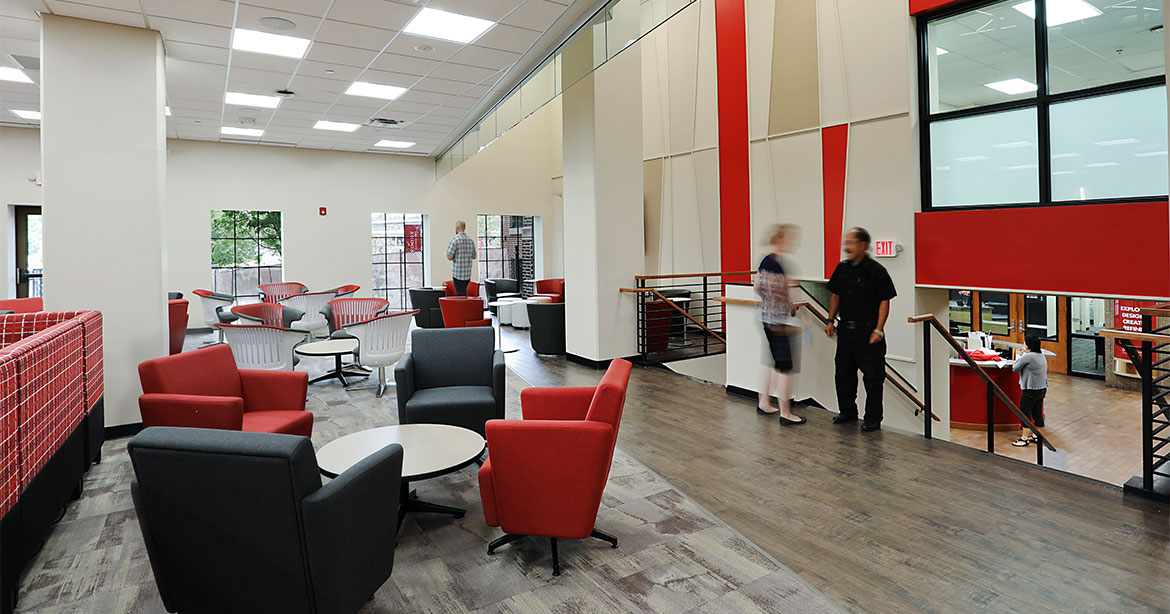
Aging infrastructures, outdated facilities, and decreased enrollment all weigh heavily on the minds of higher education institutions. Amid declining enrollment rates, colleges and universities are prioritizing campus improvements to help attract and retain students. Here are the top trends Mortenson’s experts are currently seeing in the higher education construction market.
1. Residence Halls with Diverse Room Options
A lot of residence halls are older and lack amenities—quite the opposite of the bright, modern, and collaborative spaces that students prefer today. That, paired with housing capacity issues, puts residence halls at the top of the list when considering improvements.
Students spend a lot of time in their residence halls and want to have comfortable living quarters. As a result, campuses feel pressure to renovate existing buildings or build new residence halls to attract and retain students. Augustana University in Sioux Falls, for example, developed a multi-year plan to modernize and expand its on-campus housing. The plan includes a new residence hall, renovating two existing residence halls, and other campus upgrades.
Elevated design is also part of this trend, with many of today’s residence halls resembling apartments with upscale amenities. Private, one-room studios grew in demand during the pandemic and have remained a high-priority item for students. Another space trend is dorms with communal living areas and separate bedrooms. Private bathrooms are becoming more commonplace, too. However, even with an increased demand for privacy, students still want collaborative indoor and outdoor spaces to relax, study, and connect with others.
Offering diverse on-campus housing options is important not only for recruiting and retaining students, but to give campuses the flexibility to pivot if a need for separate housing arises again, as it did during the COVID-19 pandemic.
2. Amenity-Packed Student Unions and Student Centers
Campuses want to provide amenities that entice students to linger on campus after class instead of heading straight home—the benefit is a feeling of community, which can help improve academic success. The need has pushed student centers and student unions near the top of higher education construction “to-do” lists.
Designed and built to impress, these gathering spaces are renovated and built to provide a bright, airy feel for students, faculty, and staff. Must-have amenities include ample collaboration spaces with comfortable seating. Private study areas are a must, too. Dunwoody College of Technology in Minneapolis met these demands by renovating an existing gym into a bright, modern space with a welcome center, learning commons, library, and admissions office.
In addition to study and learning spaces, students want entertainment options like bowling alleys and TV rooms. Wellness-focused services have also become more popular as students and campuses prioritize mental health. And, of course, student centers need plenty of food, coffee, and snack options available during the day and evening.
3. Campus-wide Focus on Sustainability
University and college campuses feel tremendous pressure from high school students and their parents to have sustainable campuses. However, sustainability initiatives go beyond recycling bins and compostable containers in the cafeteria. Behind-the-scenes changes are equally important, like using sustainable building materials, reducing water consumption, and installing energy-efficient mechanical-electrical equipment.
While some campuses tackle mechanical and energy upgrades as they build and renovate spaces, others are completely overhauling their infrastructure to create their own campus utility systems. One example is the University of Seattle’s utility plant, which supplies chilled water and emergency power to research buildings on campus. The building has multiple sustainability features, and it received an Envision Gold Award from the Institute of Sustainable Infrastructure. These critical upgrades help campuses meet their sustainability goals and help reduce long-term operational costs.
Campuses recognize the importance of creating an attractive and welcoming environment for students, faculty, and visitors. The focus areas mentioned above, along with improvements to classroom spaces, make for a better learning environment and help promote a sense of pride in the campus community.
Shaping the World of Things to Come
Mortenson’s education construction experts work with colleges, universities, and K-12 schools across the U.S. to reimagine and improve the student experience. Partner with a company invested in helping you build better campuses for generations to come.